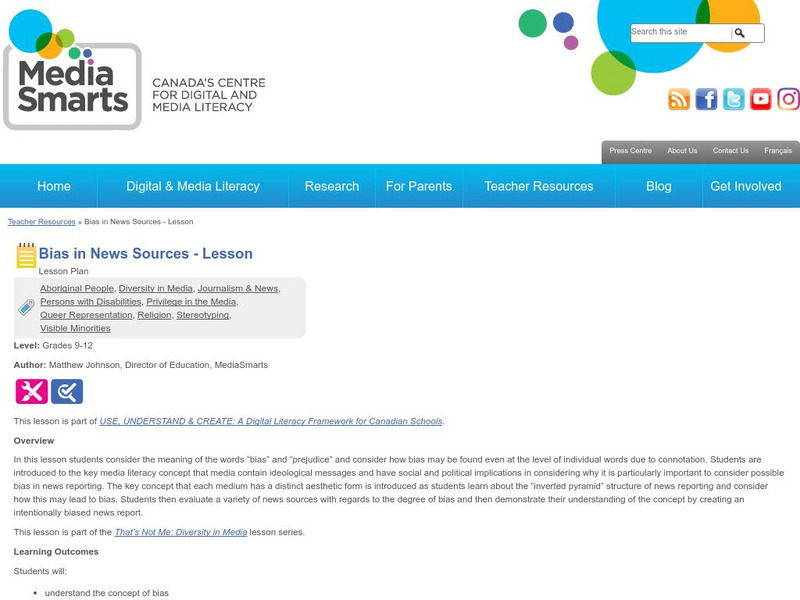Hi, what do you want to do?
Curated OER
Whose Buffalo?
Seventh graders examine how the Plains Indians vied with white commercial buffalo hunters for the millions of Great Plains buffalo. They create an illustrated broadside supporting the interests of either the Indians or the commercial...
Curated OER
Name Brands
Students explore the possibility that a products name might bias a consumers decision to buy a particular product. The question remains to be answered, "Why do consumers buy what they buy and why that particular product?"
Curated OER
Japan's Textbook Case
Students read and discuss "Japan's Refusal to Revise Textbooks Angers Neighbors." They discuss how accurately textbooks account for historical events, then collaborate to write unbiased textbook entries for current events.
Curated OER
From Whose Perspective?
Students critically analyze news coverage of Palestinian-Israeli violence by comparing information from a variety of news sources. They compose expository essays reflecting on how to obtain accurate, unbiased, and credible information.
Curated OER
Japanese Culture
Ninth graders examine the differences in the way genders have been treated in the same society over the course of a nation's history. In this World History lesson, 9th graders study the factors that have caused changes in...
Curated OER
Tolerance: Gender Issues
Students explore why some professions have been gender-dominant in the past. In this lesson plan, students identify some professions that have typically had one specific gender employed in the past, then research that job to see when it...
Curated OER
Broadcast from the Past
Students will be responsible for presenting (either performing live or videotaping and playing) a newscast dealing with an aspect of the Civil Rights Movement that connects to the unit topic of media and social justice. During the...
Curated OER
Is All Fair In War?
Students read the 1755 Bounty Proclamation and discuss what happened in Maine during this time period. With a partner, they use the text and dictionary to look up any word they do not know. They participate in a think, pair, share to...
Curated OER
The Study of the Spanish-Speaking People of Texas: Understanding Primary Sources
Learners analyze Russell Lee's photo essay as a sign of segregation in Texas. They consider the differences between primary and secondary sources and how historians use these sources.
Curated OER
The Artist as Entrepreneur: Are You Listening?
Students study non-verbal communication through appearance, movements and voice. They evaluate the non-verbal communication of television reporters and then participate in role-play scenarios using non-verbal communication.
Curated OER
History and Human Rights: A Process for Analyzing Events
Students analyze various American History topics which concern human rights. They research the topics and analyze the sources for bias or stereotype. They decide and discuss whether or not any human right were violated in each...
Curated OER
Understanding Causes of Global Conflict: Peer Interviews
Students examine sources of conflict. In this global conflict instructional activity, students discuss how peer pressure, bias, oppression, ethnocentrism, miscommunication, and fear contribute to personal conflict as well as global...
Curated OER
THE LION AND THE MOUSE
Young scholars listen to a story about different types of animals and explore how they all need each other, just like people do.
Curated OER
A Bison Web
High schoolers view a documentary on the treatment of the buffalo. In groups, they create a website using ideas and solutions they developed. They must include graphics or animation and a multi-level webpage. They share their pages...
Curated OER
Bill of Rights -- Texas v. Johnson, 1989
Students examine the First Amendment of the Bill of Rights. During a visit to the George Bush Presidential Museum, they watch a video about the Texas v. Johnson flag burning case. In groups, they discover the role of the Supreme Court...
Curated OER
Our Unfinished Work
Pupils investigate the racism elements after the election of President Barack Obama. In this racism lesson, students read a recent article about 'post-racial' society. Pupils compile a list of achieving a post-racial society and devise a...
Curated OER
Conspiracy Theory: Lincoln's Assassination
Young scholars determine how the Lincoln assassination impacted the United States. For this conspiracy theory lesson, students examine selected primary sources and chart the information they gather from the sources.
Curated OER
Can I Feel Your Pain? A Sculpture Project
Students conduct research dealing with some aspect of human rights in Latin America. They create a sculpture as a response to an instance of repression that touched them from their research. They give a brief oral report on their country.
Curated OER
Fly, Fly Away
High schoolers use materials from their own environment to design a kite. In this kite design activity, students research the history of kites and obtain a formal mathematical definition of a kite. High schoolers sketch kite designs...
Curated OER
Examining newspapers
Students compare and contrast tabloid and broadsheet papers. In this journalism lesson plan, students examine how techniques and form differs from one type of publication to the other. The culminating activity is for students to take...
Curated OER
JAPANESE CULTURE
Young scholars explore the Japanese culture and stereotypes involving it.
Curated OER
We Need Cash
Middle schoolers describe charitable, religious, and civic services in their community, and argue for the value of these services. They write a one-page explanation as to why this service is important to the community and why it deserves...
Curated OER
Effective Photojournalism
Students determine what makes a quality photo and take and edit appropriate photos that relate to their assigned articles. They select good pictures for their publication.
Media Smarts
The Media Awareness Network: Bias
Slant, or bias, can be found in virtually every news outlet. Use this online lesson plan to help students understand how word choices and other factors can intentionally or unintentionally affect the audience's understanding.




























